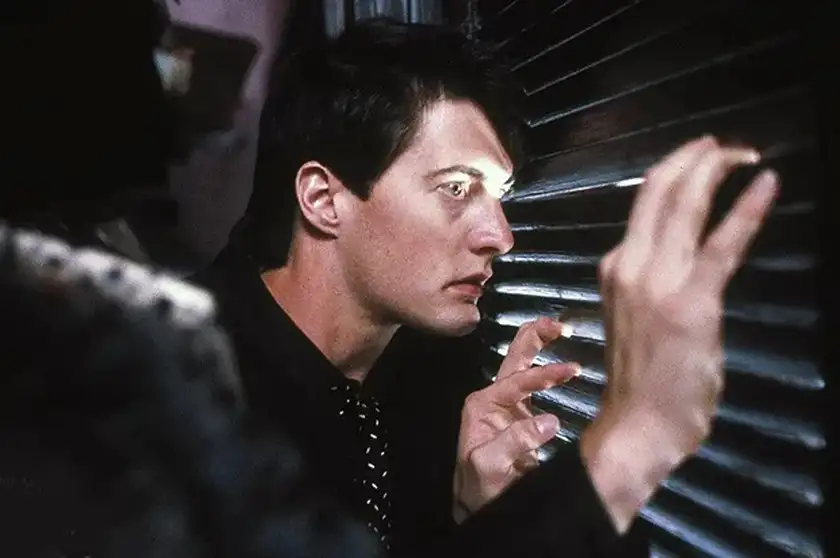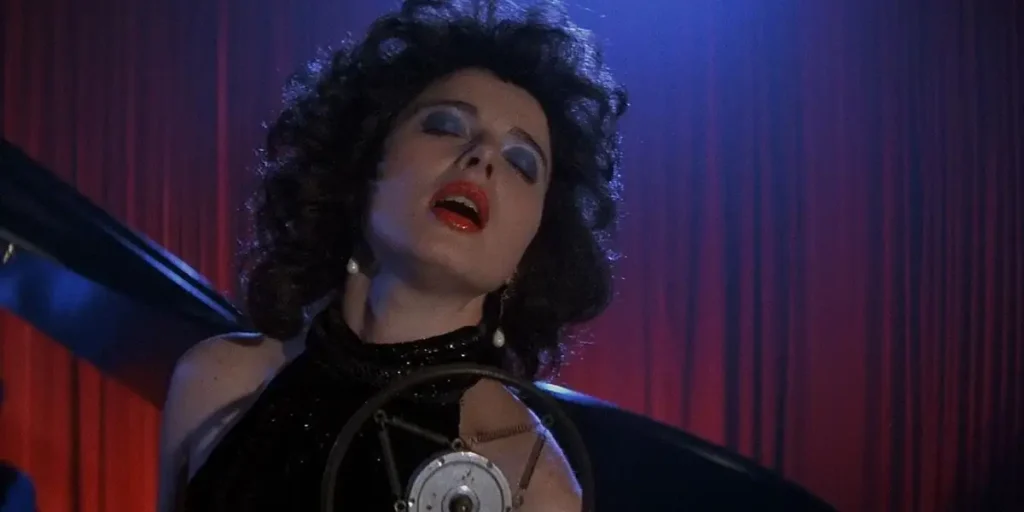David Lynch’s Blue Velvet introduced moviegoers to his uncanny view of of the world, setting the template for what would become known as ‘Lynchian’.
Blue Velvet begins with a severed human ear in the grass of an abandoned lot. David Lynch’s controversial classic draws you into its mystery with a gripping, provoking hook. To whom did the ear belong and who cut it off? Rather than answer that burning question in a straightforward manner, Lynch leads the viewer on a journey into the heart of darkness, a guided tour of evil, depravity and trauma. It is an intense, emotionally assaultive work that haunts the mind long after the closing credits have rolled. Whether you love it or hate it, you will never be able to forget your experience watching this movie. The singular, unmistakable experience of Blue Velvet make it a perfect look into what exactly makes a David Lynch movie ‘Lynchian.’
Blue Velvet, released in 1986, was the fourth feature film directed by Lynch, and the first that takes place in the contemporary world, one that bares at least a passing resemblance to the world of the viewer. The movie’s setting is small town America, Anytown, USA, not the Industrial hellscape of Eraserhead, or the Victorian Era London of The Elephant Man, or the fantastical planets of Dune. It is also one of the most autobiographical of Lynch’s films, based around memories of growing in small town America, and his own dreams and fantasies.
As Jeffrey Beaumont, Kyle MacLachlan is dressed nearly identical to Lynch, complete with a dress shirt buttoned all the way to the top. There are images and sequences in Blue Velvet of such visceral immediacy that it seems as though they were beamed directly from Lynch’s subconscious, making the experience of viewing them extremely uncomfortable; they are too private for a stranger such as yourself. The searing quality of Blue Velvet, both visually and emotionally, make it a perfect case study into what exactly makes up the work of David Lynch. If you were asked to close your eyes and visualize an image from the cinematic work of David Lynch, there’s a strong possibility the mental picture you conjured is found somewhere in Blue Velvet.
The plot of Blue Velvet is a woozy mix of film noir pulp, gothic horror, and Grimm’s fairy tale. Wide-eyed Jeffrey Beaumont (Kyle MacLachlan) unhappily returns from college to his hometown of Lumberton after his father suffers a medical emergency. Walking home from the hospital one afternoon, Jeffrey happens upon a severed human ear lying in the grass of an empty lot. Perhaps searching for an escape from his troubles, Jeffrey lets curiosity get the better of him, and he sets out to uncover the mystery of the ear. He is joined in his Hardy Boys-like adventure by the Police Chief’s daughter, girl-next-door Sandy, played by a luminous Laura Dern. Jeffrey’s investigation leads him to the sultry nightclub singer Dorothy Vallens (Isabella Rossellini). After having snuck into her apartment closet, Jeffrey spies Dorothy’s victimization and abuse by the devilish Frank Booth (Dennis Hopper). As a masochistic, sexual connection forms between Jeffrey and Dorothy, the naive young man falls deeper into a depraved, dangerous hell.

Growing up in the Pacific Northwest, David Lynch had what he would describe as an idyllic childhood. “Smiles were pretty much all I saw,” he once said in an interview with Rolling Stone, but they were “strange smiles… smiles of the way the world could be or should be.” It is that exact condition, the tension between the wholesome presentation and the ugly trauma that hides behind the door, that appears time and time again in Lynch’s work. Many people have tried to collate a definition for the nebulous term ‘Lynchian.’ One of the many was David Foster Wallace, who, in an article for Premiere Magazine, wrote that Lynchian “refers to a particular kind of irony where the very macabre and the very mundane combine in such a way as to reveal the former’s perpetual containment within the latter.” For Lynch, anxiety comes from the fact that light and dark co-exist, that life is never quite as peaceful as it was during childhood or as it appears in the movies. He’s interested in the space between “should” and “does.”
The German have a term called unheimlich, which translates as “unhomely” or “the uncanny.” The uncanny takes the familiar and comforting, and tweaks it ever so slightly off its axis. This leaves the viewer with a sense of dread and unease they often cannot articulate, but reminds them of what they have long wanted to hide away and repress. In Blue Velvet, the Chief of Police responds to Jeffrey’s presentation of the severed ear with a cheerful grin and a deadpan, “That’s an ear all right;” Dorothy is only seen without an obvious wig for a brief, blink-and-you’ll-miss-it second; Ben does not sing Roy Orbison’s ‘In Dreams’ but lip syncs; a naked and battered Dorothy stands in Sandy’s wholesome living room; a man sports sunglasses while walking his dog at night. These moments are uncanny.
Even the dialogue, with its stilted deliveries and drawn-out pauses, does not match the way we have been trained to expect characters in movies to talk. Uncanniness extends to the very plot in Lynch’s work. In the end of Blue Velvet, Frank Booth is defeated, Dorothy is reunited with her son, and the Robin’s have returned, but you are left not trusting the resolution. Something, perhaps the unnaturally bright light surrounding Jeffrey and Sandy as they reunite, perhaps the obvious mechanical quality of the Robin, perhaps the mournfulness of Rossellini’s voice as she croons ‘Blue Velvet,’ tells you there are more mysteries left on the outskirts of the movie, and leaves you in the unsettled state known as the uncanny.
Over the decades, Lynch has inspired countless filmmakers, from Stanley Kubrick to the Coen Brothers to Richard Kelly to Osgood Perkins. One thing I believe that sets Lynch apart from his progenitors is the balancing of mood and atmosphere. His impersonators lean too far into either satire or horror, failing to blend together the two tones, as Lynch does. In my opinion, the secret ingredient to Lynch’s movies is his sense of humor. They are funny. On purpose. While Lynch’s movies contain upsetting, challenging violent elements and sequences of impenetrable surrealism, they are surprisingly rewatchable. In her review of Blue Velvet, Pauline Kael referred to Lynch as “the first populist surrealist- a Frank Capra of dream logic.” As far as surrealist filmmakers go, David Lynch achieved fairly mainstream success.
That is due in part to his movies being both pieces of art and pieces of entertainment. Audiences are far more likely to accept a quote unquote confusing dream sequence, or a punishing scene of abuse and violence, if they know they will be able to laugh during the next scene. Blue Velvet is an extremely funny movie, from Jeffrey’s chicken walk to Frank Booth’s exclamation of “Heineken? F*ck that sh*t. Pabst Blue Ribbon.” The humor has the effect of, at first unsettling the audiences and continuing the uncanny sensation, as they are surprised to find themselves laughing, but once they have settled into the tone, the laughter helps them to relax and enjoy the ride that Lynch is taking them on. It’s all a movie. It’s entertainment.
There will never be another David Lynch. Many have attempted to replicate his particular tone and style, but none have succeeded. Lynch has a filmmaker of singular vision, that asked the audience to watch his movies with their emotions. Perhaps it is that quality, the intensity of the emotions aroused when watching a movie by Lynch that makes coming up with a definition for the term, ‘Lynchian’ so difficult; everyone is going to react to his work in different ways. It is this sense of the personal that sets Lynch apart, that we are being invited to into one man’s dreams and obsessions, and, perhaps, asked to consider our very own.
Blue Velvet is now available to watch on digital and on demand.

